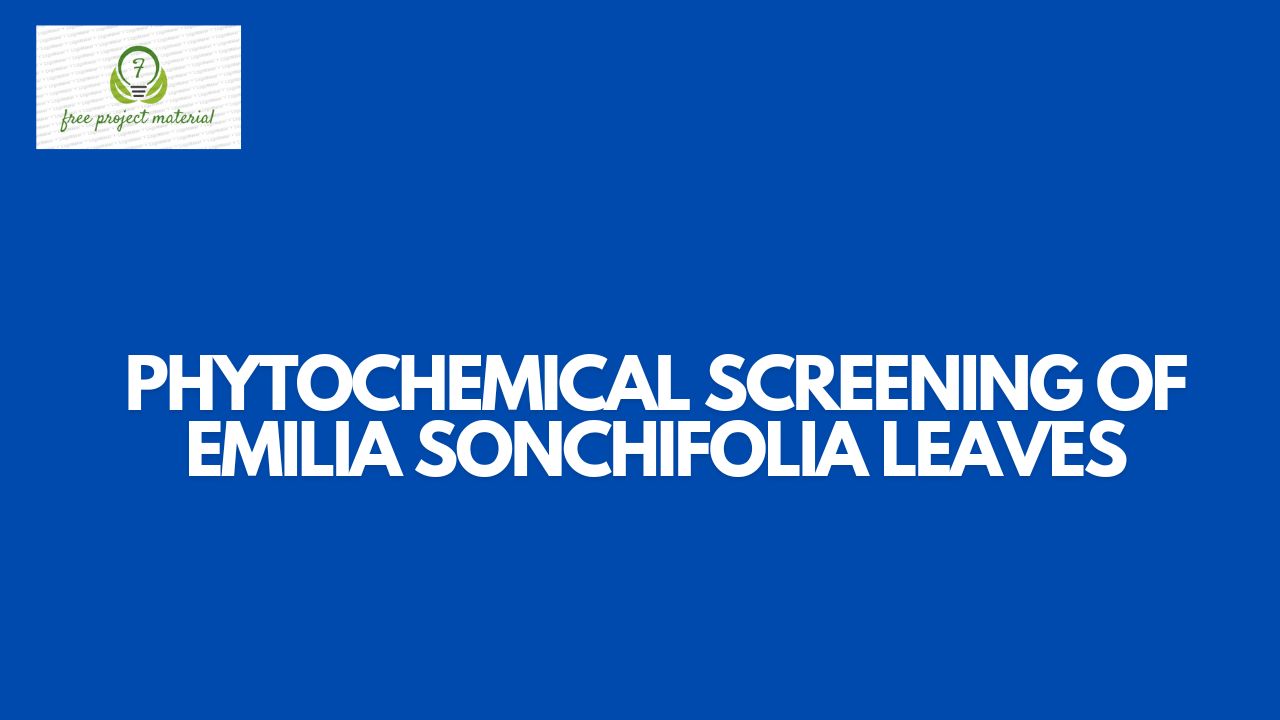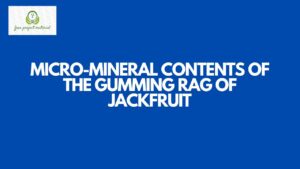ABSTRACT
The phytochemicals screening of Emilia sonchifolia leaves was carried out using standard analytical methods. The result of the study revealed that saponins, tannins and cardiac glycosides (when using Salkowiski’s test) were highly present (+++), while alkaloids and cardiac glycosides (liebermans’s test) were moderately present (++) and flavonoids was present in trace amount (+). This result suggest that the plant could serve as an important agent for the management and treatment of diseases. The use of the plant for the as antimicrobials and as diuretics is recommended due to the high presence of saponin and tannins.
TABLE OF CONTENTS
Title Page – – – – – – – – – i
Certification – – – – – – – – – ii
Dedication – – – – – – – – – iii
Acknowledgments – – – – – – – – iv
Table of Contents – – – – – – – – v
Table of Contents – – – – – – – – vi
CHAPTER ONE: INTRODUCTION
1.1 Background of the Study – – – – – – 1
1.2 Aim and Objectives of the Study – – – – 4
1.3 Scope and Limitation of the Study – – – – 5
CHAPTER TWO: LITERATURE REVIEW
2.1 Original of the Plant – – – – – – 6
2.2 Scientific Classification of Emilia songifolia – – – 6
2.3 Description of the Plant – – – – – 7
2.4 Species of the Plant – – – – – – 8
2.5 Medicinal Uses of the Plant – – – – – 10
2.6 Classification of Phytochemicals and their Importance – 11
2.7 Flavonoids – – – – – – – – 11
2.8 Tannins – – – – – – – – 12
2.9 Alkaloids – – – – – – – – 13
2.10 Terpenes – – – – – – – – 14
2.11 Saponins – – – – – – – – 15
2.12 Cardiac Glycosides – – – – – – 16
2.13 Phenolic – – – – – – – – 17
CHAPTER THREE: MATERIALS AND METHODS
3.1 Materials and Reagents – – – – – – 19
3.2 Collections of Sample – – – – – – 19
3.3 Preparation of the Extract of Sample – – – – 19
3.4 Phytochemical Screening – – – – – – 20
3.5 Test for Alkaloids – – – – – – – 20
3.6 Test for Flavonoid – – – – – – – 20
3.7 Test for Saponin – – – – – – – 21
3.8 Test for Tannin – – – – – – – 21
3.9 Test for Cynogenic Glycosides – – – – – 21
CHAPTER FOUR: RESULTS AND DISCUSSION
4.1 Results – – – – – – – – 22
4.2 Discussion – – – – – – – – 23
CHAPTER FIVE: CONCLUSION AND RECOMMENDATIONS
5.1 Conclusion – – – – – – – – 27
5.2 Recommendations – – – – – – – 27
References
CHAPTER ONE: INTRODUCTION
1.1 Background of the Study
Over the years, man has used plant (whole or parts) for food, aesthetic beautification, and medicine and for the feeding of livestock. Plants have economic values and are not only used for mere satisfaction or sustenance of hunger but also for the maintenance of good health.
Plants are rich sources of natural products, they form the major parts of ingredient in almost all system of therapeutics pharmaceutical industries are conducting extensive research on plants collected from the rain forest and other places for their potential medicinal values; modern allopathic system of medicine is also based on plants and herbs. Medicinal plants are relevant in both developing and developed nations of the world as sources of drugs or herbal extracts for the various chemotherapeutic purposes continue to play a dominant role in maintaining human health since antiquities.
Over 50% of all modern clinical drugs are of natural product origin and natural products plays an important role in drug development programme of the pharmaceutical industry. In the continuation of this strategy of new drug discovery, emphasis has been laid on the aerial parts of most plants for their antibacterial and anti-oxidant properties. Gayanthri (2012) had posited that modern clinical drugs of natural products plays an important role in pharmaceutical industries, chemicals which are naturally present in plants are converted traditionally and medicinally into substances that regulate human fertility. Some secondary compounds produced by plants could be very effective against parasites and pathogens such as plants include pawpaw, mango, citrus as well as Emilia sonchifolia (Brianna et al., 2011). Emilia sonchifolia (composite) is an herbaceous plant which grows up to about 10 – 40cm in height. Develops ripe fruits between August to October, the flowers are hermaphrodite and are pollinated; the plant is pantropic and probably originated from South Asia.
Emilia sonchifolia has been found to be very effective in the treatment of several diseases, such as sore throat, wound healings, conjunctivitis, infantile diarrhoea and the like. In India for instance, the leaves extract of this plant have been used to treat dysentery. The aerial part is believed to contain flavonoids, terpenes and alkaloids. In Africa, the tea made from the leaves of Emilia sonchifolia is used in folk medicine for the treatment of dysentery. The juice extract of the leaves is used for the treatment of cuts and wound, sore ears etc. The juice of the root is used for the treatment of diarrhoea while the flower heads are kept in the mouth for some minutes to prevent tooth decay (Essien et al., 2009).
In Cameroun, it is used as a local remedy for craw – craw and in Brazil, the aqueous extract of the leaves and whole plants have been used to treat flu, cold and fever, diarrhoea, rheumatism and spasm (Couto et al., 2000). The leaves have also been exploited as tea plant for the anti-inflammatory, analgesic, anti-diarrhoeal agent and for the healing of gynaecological diseases. It is used as emetic, stomach ache dysentery and bowl complaints (Ekukudo, 2001).
Duke and Ayensu (2005) had also reported that the juice of the leaves is used in the treatment of eye inflammation, night blindness, cuts and wounds as well as ear infections. The plant leaves extract have also been reported to be an astringent depurative used for the treatment of infantile lympanities and bowl constipations.
In central Africa, Emilia sonchifolia has been widely used in the treatment of pneumonia, wound healing and burns, skin diseases, mental retardation, infectious diseases, migraine headache, asthma, abdominal heat reduction in pregnant women and urinary infections (Mcfarl and Lynn, 2007).
Apart from its medicinal value, Emilia sonchifolia have high nutritional value as an edible plant where is serves as a mild laxative agent. Phytochemical screening of the plant by Muko and Ohiri, (2000) have revealed that the plant contains palmitic acid, alkaloids 0.2%, aechuain (isoflavone), doronine, kuemferol, rhamnopyranoside, 1- 2, B-D –glycopyranoside, meanrsetin, simiral and senkinine some of which are very effective against diarrhoeagenic pathogens.
1.2 Aim and Objectives of the Study
The aim of this study is to carryout the phytochemical screening of Emilia sonchifolia leaves.
The Objectives of the Study are
- To enumerate the medicinal importance of Emilia sonchifolia
- To qualitatively screen the phytochemical constituent of the plant
1.3 Scope and Limitation of the Study
This study focus only on the phytochemical screening of Emilia sonchifolia leaves due to time and financial constraint.


